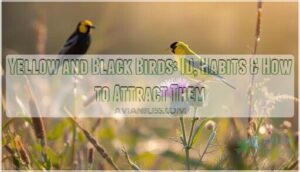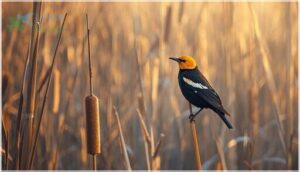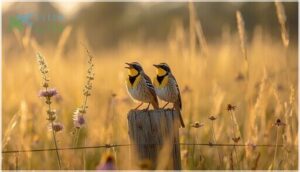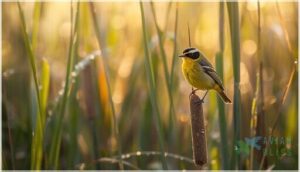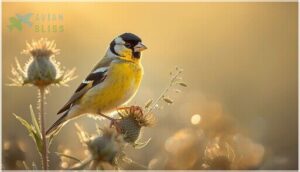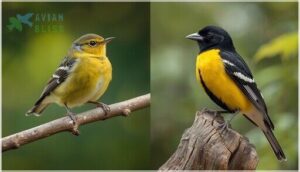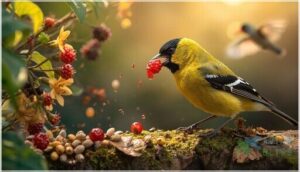This site is supported by our readers. We may earn a commission, at no cost to you, if you purchase through links.
You don’t need binoculars to spot them—these yellow and black birds announce themselves like nature’s highlighters. The American Goldfinch bounces through summer meadows in breeding gold, while Yellow-Headed Blackbirds stake their marsh territories with calls that carry across wetlands.
Their bold color schemes aren’t random fashion statements. Diet shapes their vibrant yellows, from thistle seeds packed with carotenoids to insects rich in pigment precursors.
Habitat, season, and even time of day shift what you’ll see at your feeder. Understanding these patterns transforms casual birdwatching into targeted species identification, whether you’re tracking a masked Common Yellowthroat through streamside willows or distinguishing an Evening Grosbeak’s chunky silhouette against winter pines.
Table Of Contents
- Key Takeaways
- Common Yellow and Black Bird Species
- Physical Characteristics and Identification
- Habitats and Geographic Distribution
- Diet, Foraging, and Coloration
- Behavior, Breeding, and Conservation
- Frequently Asked Questions (FAQs)
- What kind of bird is black and yellow?
- What is a yellow-headed bird with a black body?
- Are yellow-headed blackbirds endangered?
- What is a yellow bird with a long black tail?
- What roles do carotenoids play in bird coloration?
- How does melanin affect bird feather colors?
- When do blackbirds typically migrate?
- How do yellow and black birds attract mates?
- What are blackbirds common food sources?
- How do yellow and black birds avoid predators?
- Conclusion
Key Takeaways
- Diet directly controls yellow feather intensity through carotenoid pigments from seeds and fruits, while black coloring comes from melanin independent of what birds eat—meaning your feeder choices genuinely affect how vibrant visiting goldfinches and tanagers look.
- Species identification hinges on combining color with size, habitat preference, and behavioral markers like song patterns or flight style, since relying on yellow-and-black plumage alone won’t distinguish a 0.32-ounce goldfinch from a 1.5-ounce blackbird.
- Conservation pressures hit hardest in fragmented habitats where wetland loss has eliminated over 282,000 km² of breeding territory for species like Yellow-headed Blackbirds, now endangered in Illinois with populations down to just 70–1,200 birds.
- Backyard habitat improvements—native plantings, appropriate seed feeders, and water features near cover—boost bird visits by 35–70% and turn casual observation into active conservation that counters population declines you can measure from your own window.
Common Yellow and Black Bird Species
You’ll find yellow and black birds in backyards, meadows, and wetlands across North America. These striking color combinations aren’t random—they serve real purposes in nature, from attracting mates to warning off rivals.
Here are eight species you’re most likely to spot, each with its own distinct markings and personality.
American Goldfinch
You’ll spot the American Goldfinch by its bright yellow plumage and jet-black forehead during breeding season. These backyard favorites flock together year-round in the eastern U.S., drawn to sunflower and thistle seeds. Goldfinch migration peaks in late April and September across the central states.
Their beak structure perfectly manages seed extraction, while careful feather care maintains that striking yellow-and-black contrast that makes bird identification a breeze.
Understanding the importance of themes can help writers create engaging stories about these birds.
Yellow-Headed Blackbird
Head into western wetlands and you’ll find the Yellowheaded Blackbird perched in dense cattails. Males flash that golden head and chest against black bodies—plus a white wing patch during flight.
These North American bird species breed in marshes from Canada to Missouri, then migrate south to winter fields. Their breeding patterns rely on deep-water habitat, where nesting colonies protect eggs from predators.
Listen for their distinct, raspy song variations echoing across open water. The conservation of wetland habitats is vital for the survival of these birds.
Western and Eastern Meadowlark
You’ll find these iconic grassland birds belting out flute-like melodies from fence posts across open prairies. Western and Eastern Meadowlark species sport bright yellow breasts with bold black bibs, making bird identification straightforward. Their song patterns differ—Western rolls with rich whistles, Eastern descends melodically—key for North American bird species recognition.
Meadowlark migration brings them north each spring, but grassland ecology losses threaten populations. Conservation efforts focus on preserving native habitats where meadowlark behavior thrives.
Common Yellowthroat
Unlike meadowlarks, you’ll catch Common Yellowthroats slipping through marsh grasses with their signature black mask—a warbler identification win for North America’s wetlands. Males defend territories through song variations during breeding patterns, while migration routes take them south each winter.
Habitat restoration efforts boost populations where dense vegetation thrives. Watch for their yellow throats and quick, secretive movements through reeds—feather care happens low in the brush.
Hooded Warbler
You’ll know a Hooded Warbler by its striking black hood framing a yellow face—a standout in any bird identification guide. Males defend dense forest understories during breeding patterns, then follow migration routes to Central America each fall. Conservation efforts target habitat fragmentation threatening these songbirds:
- Nesting success drops 40–60% in fragmented forests
- Plumage variation shows subtle differences across populations
- Shrub density between 0.5–2.5 meters boosts survival rates
Lesser Goldfinch
You’ll spot the Lesser Goldfinch’s glossy black crown and bright yellow underparts at backyard bird watching and feeding stations across the Southwest. Males flash bolder plumage than females during molting patterns, while their conical beak adaptation suits seed preferences from sunflowers to thistle.
Their flocking behavior mirrors the American Goldfinch, making this yellow and black bird a prized entry in any bird identification guide.
Evening Grosbeak
You’ll recognize the Evening Grosbeak by its bold yellow body, black mask, and thick, conical beak—built for cracking conifer seeds across boreal forests. This powerhouse travels in flocks during North American bird migration, tracking spruce cone crops from Canada’s edge to your backyard bird watching and feeding setup.
- Feather structure: Males flash brighter yellow and black plumage than muted females.
- Seed preferences: Spruce and pine dominate their diet year-round.
- Flocking patterns: They join mixed-species groups during migration routes and winter dispersal.
- Beak function: Heavy bills excel at husking tough conifer seeds for bird identification and classification.
Western Tanager
The Western Tanager stands out during western migration with its fiery orange-red head and bright yellow body against black wings—a beacon across coniferous forests from British Columbia to Mexico. This avian adaptation contrasts with the Yellow Warbler’s softer tones, making bird identification and classification straightforward despite shared yellow and black coloring across North America. You’ll hear tanager songs echoing through mature canopies where forest ecology sustains their insect-heavy diet.
| Feature | Male Breeding | Female/Juvenile |
|---|---|---|
| Head Color | Orange-red | Olive-yellow |
| Body | Bright yellow | Duller yellow-green |
| Wings | Black with bars | Brownish-gray |
| Habitat | Conifer forests 1,000-2,500m | Same elevation range |
| Migration | Long-distance neotropical | Year-round in Central America |
Physical Characteristics and Identification
You can’t identify a bird by color alone—size, shape, and markings tell the real story. Yellow and black birds range from tiny warblers barely three inches long to hefty grosbeaks pushing ten inches, and each species carries its own signature details.
Let’s break down the physical traits that’ll help you nail the ID every time.
Plumage Patterns and Colors
You’ll notice that yellow and black bird species showcase striking plumage patterns shaped by pigments and molt cycles. American Goldfinch males shift from olive to bright yellow during breeding, with black forehead and wings covering roughly 32% of their visible area. Yellow-Headed Blackbirds flaunt bold yellow heads averaging 58% facial coverage.
Feather structure and iridescence effects intensify these color morphs, while beak colors and seasonal molt patterns create the dramatic contrasts you observe in yellow plumage and black feathering.
Size, Weight, and Wingspan
Size variations among yellow and black birds range dramatically—you’ll find the tiny American Goldfinch weighing just 0.32 ounces with a 7.5-inch wingspan, while the sturdy Yellow-headed Blackbird tips scales at 1.5 ounces with wings spanning 18 inches.
Body proportions and wingspan measurements help you distinguish species instantly; Western Meadowlark reaches 16-inch wingspans, dwarfing delicate Yellow Warblers that barely stretch 8 inches.
Distinctive Markings and Features
Beyond dimensions, you’ll spot these birds by their standout features. Facial patterns and mask variations separate similar species—look for that distinctive black mask on male Yellowthroats, ranging 6–12 mm wide.
Key markers include:
- White wing bars visible on 5%–8% of species in both sexes
- Hooded Warbler’s black hood with vivid yellow face
- Western Tanager’s red-orange throat contrasting yellow body
- Goldfinch white wing bars against black wings
- Beak shapes and feather textures varying by foraging style
Male Vs. Female Differences
Yellow and black birds exhibit striking sex-based differences. In 85.6% of species, males display brighter yellow patches and darker black areas, while females tend toward muted yellow-green or brown tones. This plumage dichromatism aids in quick identification.
| Feature | Males | Females |
|---|---|---|
| Color Intensity | High-saturation yellow, ornamental black | Duller yellow-green, brown streaks |
| Size Dimorphism | Yellow-headed Blackbird: 44–54 g | Yellow-headed Blackbird: 32–51 g |
| Song Complexity | Complex territorial songs, 2–3× higher output | Simple calls or silent (89% of populations) |
| Parental Roles | Reduced care in ornamented species | Primary nest-building and chick care |
Males with vivid yellow plumage generally invest less in parenting, leaving females to handle most nesting duties.
Habitats and Geographic Distribution
Where you spot these yellow and black birds depends on what they’re after—some hang out in dense forests, while others prefer wide-open fields or marshy wetlands.
Their ranges stretch across North America, with each species claiming its own territory from Canada down to Central America.
Whether they stick around all year or chase the seasons, knowing where they live helps you find them.
Preferred Habitats (Forests, Wetlands, Fields)
Across North America, you’ll find yellow and black birds thriving where habitat meets opportunity. Forest edges draw 64% more breeding species than deep woods, while wetlands with floating vegetation support 33% higher warbler abundance. Open fields with tall native grasses boost meadowlark foraging by 26%.
Habitat fragmentation threatens these ecosystem services, so protecting diverse landscapes—forests, wetlands, and fields—keeps these bold beauties singing.
Regional Ranges in North America
You’ll spot these species from coast to coast, each claiming its own slice of North America. Western Meadowlark rules the Rockies to the Pacific, while Eastern Meadowlark sticks to the Great Lakes and Southeast. American Goldfinches breed across southern Canada down through central states, and Yellow-Headed Blackbirds dominate prairie wetlands.
Geographic distribution and habitat preferences shape where you’ll find each bird’s range dynamics unfolding.
Migratory Vs. Resident Species
Migration patterns split these birds into distinct groups based on seasonal movement. Some species, like Yellow-Headed Blackbirds, travel hundreds of miles from Canadian breeding grounds to Mexican wintering sites, while Western Meadowlarks show partial migration depending on climate impacts and food availability.
Migration triggers and stopover ecology shape these journeys:
- American Goldfinches make short-distance moves following seed availability
- Common Yellowthroats migrate August through October with peak Florida concentrations in late September
- Yellow-Headed Blackbirds move in irregular daytime flocks, roosting at wetlands nightly
- Resident adaptations keep some populations year-round in mild climates
- Regional bird distribution shifts as migratory birds respond to resource changes
You’ll notice different arrival times depending on species and geography.
Diet, Foraging, and Coloration
What these birds eat shapes more than just their energy—it actually determines how bright their feathers look. Their diets vary widely, from insects and seeds to nectar and fruits, and each species has its own hunting style. Here’s what fuels their yellow and black colors and how they go about finding food.
Typical Diets (Insects, Seeds, Fruits)
What fuels those striking yellow and black feathers? Your backyard birds rely on varied menus shaped by seasonal dietary adaptations.
| Species | Seeds (% Diet) | Insects & Fruits |
|---|---|---|
| American Goldfinch | 60-80% composite plant seeds | Minimal insects |
| Yellow-headed Blackbird | 50-70% grains | Seasonal insects |
| Meadowlarks | 40-60% grass/weed seeds | 20-40% insects (breeding) |
| Common Yellowthroat | Fall: 10-20% fruit | 70-90% insects (breeding) |
| Hooded Warbler | Rare | 60%+ caterpillars, beetles |
Seed preferences dominate winter feeding, while insect hunting peaks during breeding seasons. Lesser Goldfinches favor thistles and asters (70-90% of feeding events), and Evening Grosbeaks target conifer seeds. Western Tanagers balance arthropod consumption (40-60%) with fruit intake (20-40%).
Understanding wild bird food choices helps you attract these stunning species through strategic bird feeding in your yard.
Foraging Behaviors
Beyond what they eat, how these bird species hunt reveals their true nature. Watch for these hunting styles when identifying backyard birds:
- Gleaning techniques: Warblers pick insects from leaves and branches while moving through foliage
- Hawking strategies: Flycatchers catch prey mid-flight from exposed perches
- Probing substrates: Some species dig into bark or soil for hidden invertebrates
- Ground foraging: Meadowlarks and blackbirds walk through grass scratching for seeds
- Seasonal variations: Summer brings insect-focused bird behavior; winter shifts to seed gathering at your bird feeding stations
Understanding wild bird food preferences helps you stock feeders strategically.
Role of Diet in Yellow and Black Plumage
What you toss in your feeders directly shapes those vivid yellows you’re chasing. Carotenoid deposition from seeds and fruits builds intense yellow plumage, while melanin synthesis creates black—independent of diet. High-protein effects during molt boost color vibrancy. This honest signaling reveals bird health. Understanding deposition dynamics helps you attract stunning yellow and black birds with smart wild bird food options.
| Pigment Type | Dietary Influence |
|---|---|
| Yellow (Carotenoids) | High – seed/fruit dependent |
| Black (Melanin) | Minimal – genetically controlled |
| Overall Vibrancy | Protein quality matters |
Behavior, Breeding, and Conservation
Beyond their striking looks, yellow and black birds lead fascinating lives shaped by song, courtship, and survival. Understanding their breeding cycles, social dynamics, and conservation challenges helps you appreciate what they’re up against in a changing world.
Here’s what you need to know about their behavior and nesting habits, and how you can make a real difference in your own backyard.
Vocalizations and Courtship Displays
You’ll hear song patterns shift dramatically when breeding season hits. American Goldfinch males weave bouncing flight calls into mate attraction displays, while Yellow-headed Blackbirds create marsh-wide choruses that define territorial defense.
Courtship rituals blend vocal learning with visual flair—wing spreading, tail fanning, and elaborate posturing. Even Wilson’s Warbler and Yellow-throated Warbler use distinctive calls to claim space and attract partners in their woodland territories.
Nesting Habits and Reproduction
Nest site selection splits between ground builders like Western Meadowlark and marsh specialists like Yellow-headed Blackbird, who secure nests to cattails over water. Clutch size averages four to six eggs, with incubation periods spanning 11–13 days.
- American Goldfinch nests unusually late—July through September—when other songbirds finish breeding
- Parental care varies: some species share feeding duties while Yellow-headed Blackbird females handle everything solo
- Fledging success peaks in dense vegetation that shields nests from predators
- Yellow-throated Warbler and Orchard Oriole construct hanging nests in trees for protection
Social and Territorial Behaviors
Once nests empty, flock dynamics kick in. You’ll see Evening Grosbeaks and goldfinches travel in groups for safety.
Territorial disputes spike when Yellow-headed Blackbird males claim 100–600 m² zones each May, sometimes hosting up to 16 females. Social hierarchy forms fast—red-morph males dominate, shaping mate selection and resource defense.
These patterns reflect core principles of ornithology and bird behavior that define avian ecology.
Conservation Status and Threats
While hierarchy shapes flock life, habitat preservation and avian conservation efforts face real urgency. You’re witnessing climate shifts that trigger up to 45% wetland drought, pollution effects that impair songbird migration, and neonicotinoid exposure slashing body mass.
Habitat loss, climate-driven droughts, and pesticide exposure are pushing yellow and black birds toward crisis
Yellow-headed Blackbirds—listed as endangered in Illinois since 1977—lost over 282,000 km² of breeding space across North America.
Wildlife conservation and bird conservation efforts now restore wetlands, boosting pairs by 25% where habitat conservation succeeds, reducing species extinction risk.
Attracting Yellow and Black Birds to Your Yard
You can turn conservation awareness into real action by transforming your yard. Native plantings like coneflowers and sunflowers boost goldfinch visits by 60%, while bird feeders stocked with black oil sunflower seed draw in 70% of seed-eaters.
Add water features near cover to increase bird species identification opportunities by 35%. Smart yard layout—mixing tall grasses with shrubs—makes backyard birds feel safe and aids wildlife conservation right where you live.
Frequently Asked Questions (FAQs)
What kind of bird is black and yellow?
Several species sport black and yellow plumage. The American Goldfinch, Western Meadowlark, and Yellow-headed Blackbird are common examples.
Color patterns and species classification help you identify these striking black and yellow birds by their distinctive yellow feathers.
What is a yellow-headed bird with a black body?
You’re spotting a Yellow-headed Blackbird—males display radiant golden heads and chests against jet-black bodies. They’re common in western marshes, with populations reaching 11 million across North America’s wetlands and grasslands.
Are yellow-headed blackbirds endangered?
Yellow-headed Blackbirds aren’t federally endangered, but Illinois lists them as endangered, with only 70–1,200 birds remaining in the state.
Population trends show regional declines from habitat loss and climate threats, prompting targeted conservation efforts across affected states.
What is a yellow bird with a long black tail?
The Yellow-headed Blackbird and Audubon’s Oriole both feature striking yellow plumage paired with distinctive long black tail feathers.
You’ll spot these birds in marshes and dry forests, where their tail feather patterns aid identification.
What roles do carotenoids play in bird coloration?
Here’s the thing: carotenoid metabolism drives plumage pigmentation in American Goldfinch and similar species. Dietary influence determines color intensity, affecting visual signaling essential for bird species identification and understanding avian biology and behavior in yellow and black birds.
How does melanin affect bird feather colors?
Melanin production drives feather pigmentation through two types: eumelanin creates black and dark tones, while pheomelanin produces yellow-brown hues.
Their ratio determines color intensity and plumage patterns you’ll see in bird species identification.
When do blackbirds typically migrate?
Blackbirds follow distinct migration patterns shaped by geographic variation and climate influence. Spring timing peaks in March across North America, while autumn routes guide flocks southward from September through November, spanning up to 800 kilometers.
How do yellow and black birds attract mates?
Males showcase their fitness through bright plumage signaling and vocal displays. Courtship behavior includes flight shows and song contests.
Territory quality matters—better sites attract choosier females. Social familiarity can seal the deal.
What are blackbirds common food sources?
Despite their name, Yellow and Black Birds shift diets dramatically. Insect prey like beetles and worms dominate spring foraging habits, while fruit sources and seed consumption take over winter—dietary adaptations that fuel their vivid plumage.
How do yellow and black birds avoid predators?
You’ll often see these bird species rely on warning coloration to signal danger, while flocking behavior and startle flash displays confuse attackers. Dense vegetation provides essential cover for quick escapes.
Conclusion
Think of yellow and black birds as nature’s way of turning your backyard into a living field guide. Once you recognize that flash of gold against dark wings, you’ll start noticing seasonal shifts, habitat preferences, and feeding patterns you’d previously missed.
Stock nyjer feeders, plant native seed-bearing flowers, and keep your binoculars handy. These species don’t just visit—they reveal how color, diet, and behavior interlock across ecosystems you can observe from your own window.

